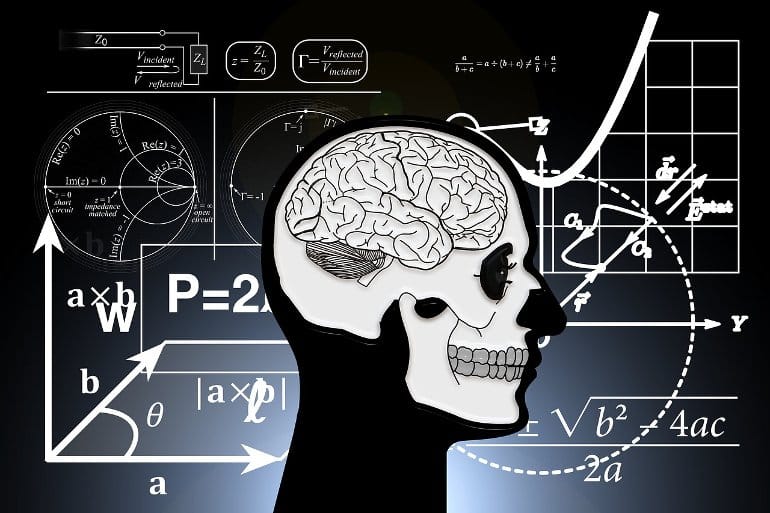Summary: Evaluating the brains of modern physicists, researchers shed light on how the brain organizes highly abstract scientific concepts.
Source: Carnegie Mellon University
The science of physics has strived to find the best possible explanations for understanding matter and energy in the physical world across all scales of space and time. Modern physics is filled with complex concepts and ideas that have revolutionized the way we see (and don’t see) the universe.
The mysteries of the physical world are increasingly being revealed by physicists who delve into non-intuitive, unseen worlds, involving the subatomic, quantum and cosmological realms. But how do the brains of advanced physicists manage this feat, of thinking about worlds that can’t be experienced?
In a recently published paper in npj: Science of Learning, researchers at Carnegie Mellon University have found a way to decode the brain activity associated with individual abstract scientific concepts pertaining to matter and energy, such as fermion or dark matter.
Robert Mason, senior research associate, Reinhard Schumacher, professor of physics and Marcel Just, the D.O. Hebb University Professor of Psychology, at CMU investigated the thought processes of their fellow CMU physics faculty concerning advanced physics concepts by recording their brain activity using functional Magnetic Resonance Imaging (fMRI).
Unlike many other neuroscience studies that use brain imaging, this one was not out to find “the place in the brain” where advanced scientific concepts reside. Instead, this study’s goal was to discover how the brain organizes highly abstract scientific concepts. An encyclopedia organizes knowledge alphabetically, a library organizes it according to something like the Dewey Decimal System, but how does the brain of a physicist do it?
The study examined whether the activation patterns evoked by the different physics concepts could be grouped in terms of concept properties. One of the most novel findings was that the physicists’ brains organized the concepts into those with measureable versus immeasurable size.
Here on Earth for most of us mortals, everything physical is measureable, given the right ruler, scale or radar gun. But for a physicist, some concepts like dark matter, neutrinos or the multiverse, their magnitude is not measureable. And in the physicists’ brains, the measureable versus immeasurable concepts are organized separately.
Of course, some parts of the brain organization of the physics professors resembled the organization in physics students’ brains such as concepts that had a periodic nature. Light, radio waves and gamma rays have a periodic nature but concepts like buoyancy and the multiverse do not.
But how can this interpretation of the brain activation findings be assessed? The study team found a way to generate predictions of the activation patterns of each of the concepts. But how can the activation evoked by dark matter be predicted?
The team recruited an independent group of physics faculty to rate each concept on each of the hypothesized organizing dimensions on a 1–7 scale. For example, a concept like “duality” would tend to be rated as immeasureable (i.e., low on the measureable magnitude scale).
A computational model then determined the relation between the ratings and activation patterns for all of the concepts except one of them and then used that relation to predict the activation of the left-out concept. The accuracy of this model was 70% on average, well above chance at 50%. This result indicates that the underlying organization is well-understood. This procedure is demonstrated for the activation associated with the concept of dark matter in the accompanying figure.
Creativity of Thought
Near the beginning of the 20th century, post-Newtonian physicists radically advanced the understanding of space, time, matter, energy and sub-atomic particles. The new concepts arose not from their perceptual experience, but from the generative capabilities of the human brain. How was this possible?
The neurons in the human brain have a large number of computational capabilities with various characteristics, and experience determines which of those capabilities are put to use in various possible ways in combination with other brain regions to perform particular thinking tasks. For example, every healthy brain is prepared to learn the sounds of spoken language, but an infant’s experience in a particular language environment shapes which phonemes of which language are learned.
The genius of civilization has been to use these brain capabilities to develop new skills and knowledge. What makes all of this possible is the adaptability of the human brain. We can use our ancient brains to think of new concepts, which are organized along new, underlying dimensions.

An example of a “new” physics dimension significant in 20th century, post-Newtonian physics is “immeasurability” (a property of dark matter, for example) that stands in contrast to the “measurability” of classical physics concepts, (such as torque or velocity). This new dimension is present in the brains of all university physics faculty tested. The scientific advances in physics were built with the new capabilities of human brains.
Another striking finding was the large degree of commonality across physicists in how their brains represented the concepts. Even though the physicists were trained in different universities, languages and cultures, there was a similarity in brain representations. This commonality in conceptual representations arises because the brain system that automatically comes into play for processing a given type of information is the one that is inherently best suited to that processing.
As an analogy, consider that the parts of one’s body that come into play to perform a given task are the best suited ones: to catch a tennis ball, a closing hand automatically comes into play, rather than a pair or knees or a mouth or an armpit. Similarly, when physicists are processing information about oscillation, the brain system that comes into play is the one that would normally process rhythmic events, such as dance movements or ripples in a pond. And that is the source of the commonality across people. It is the same brain regions in everyone that are recruited to process a given concept.
So the secret of teaching ancient brains new tricks, as the advance of civilization has repeatedly done, is to empower creative thinkers to develop new understandings and inventions, by building on or repurposing the inherent information processing capabilities of the human brain.
By communicating these newly developed concepts to others, they will root themselves in the same information processing capabilities of the recipients’ brains as the original developers used. Mass communication and education can propogate the advances to entire populations. Thus the march of science, technology and civilization continue to be driven by the most powerful entity on Earth, the human brain.
Funding: The project was funded by the Office of Naval Research and the National Science Foundation.
About this neuroscience research news
Author: Stacy Kish
Source: Carnegie Mellon University
Contact: Stacy Kish – Carnegie Mellon University
Image: The image is in the public domain
Original Research: Open access.
“The neuroscience of advanced scientific concepts” by Robert A. Mason, Reinhard A. Schumacher & Marcel Adam Just. NPJ: Science of Learning
Abstract
The neuroscience of advanced scientific concepts
Cognitive neuroscience methods can identify the fMRI-measured neural representation of familiar individual concepts, such as apple, and decompose them into meaningful neural and semantic components.
This approach was applied here to determine the neural representations and underlying dimensions of representation of far more abstract physics concepts related to matter and energy, such as fermion and dark matter, in the brains of 10 Carnegie Mellon physics faculty members who thought about the main properties of each of the concepts. One novel dimension coded the measurability vs. immeasurability of a concept.
Another novel dimension of representation evoked particularly by post-classical concepts was associated with four types of cognitive processes, each linked to particular brain regions: (1) Reasoning about intangibles, taking into account their separation from direct experience and observability; (2) Assessing consilience with other, firmer knowledge; (3) Causal reasoning about relations that are not apparent or observable; and (4) Knowledge management of a large knowledge organization consisting of a multi-level structure of other concepts.
Two other underlying dimensions, previously found in physics students, periodicity, and mathematical formulation, were also present in this faculty sample.
The data were analyzed using factor analysis of stably responding voxels, a Gaussian-naïve Bayes machine-learning classification of the activation patterns associated with each concept, and a regression model that predicted activation patterns associated with each concept based on independent ratings of the dimensions of the concepts.
The findings indicate that the human brain systematically organizes novel scientific concepts in terms of new dimensions of neural representation.






